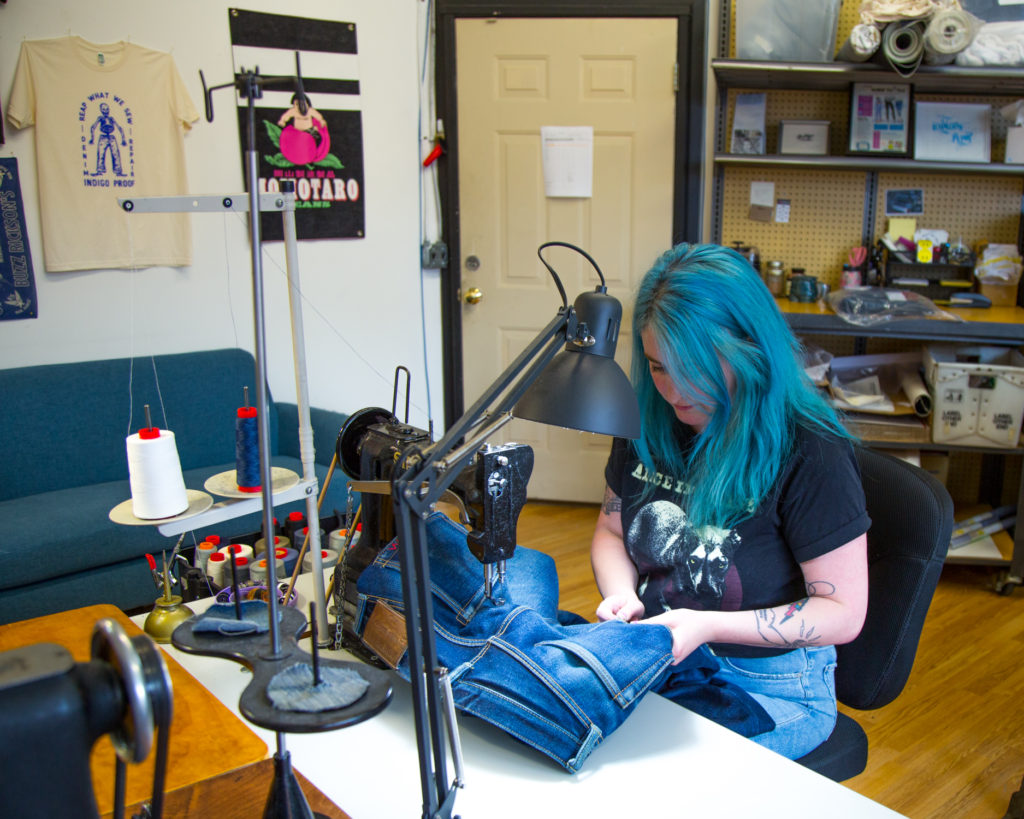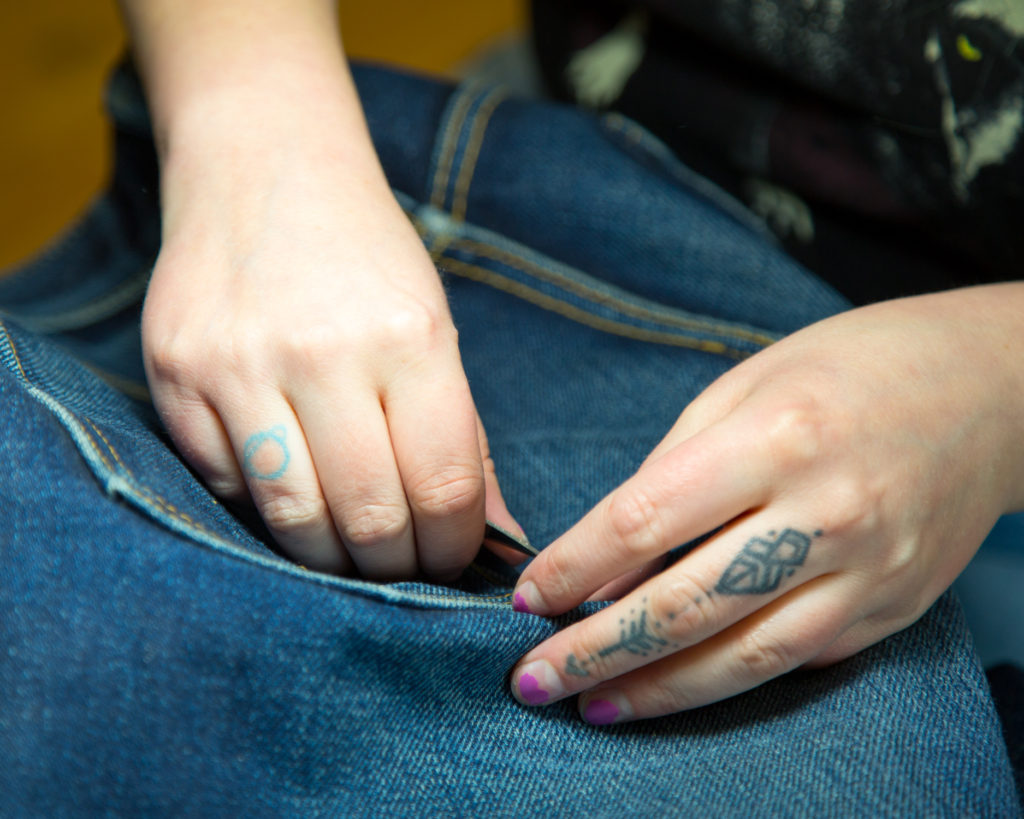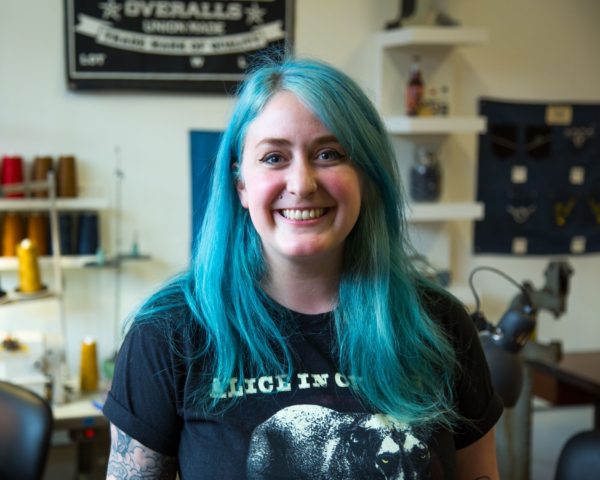Rain Delisle, founder of Indigo Proof Denim Repair, shares her thoughts on magic and labor.
In real time, there are only a few things on the internet for which I will pause a conversation to immediately look up on my phone and show whoever I’m talking to. This lion video is one of those things; the Indigo Proof Instagram page is another.
https://www.instagram.com/p/B0Jm73Ehuri/
Rain Delisle, a denim repairer and the owner of Indigo Proof, showcases her work in showstopping photos that never fail to impress: frayed holes transformed into sleek, smooth jeans. Her repairs of shredded denim are such comprehensive restorations, it’s sometimes hard to believe the chronology of her before-and-afters. Some words frequently dropped in comments on her photos are “wizardry” and “witchcraft,” which, honestly, feel very apt.
Clearly, we at Portland Repair Finder have long stanned for Rain’s repairs, so it was a pleasure to visit her shop and talk in person. We discussed her extensive denim and indigo knowledge, how it feels to be crowned a Denim Wizard by the internet, and the pros and cons that come with the title.
PRF: How did you learn about jeans repair?
RAIN: I was doing contract work, in San Francisco, within an alterations business. I was supposed to work really fast and not care what it looked like… but I cared what it looked like. That’s what pretty much informed my knowledge of repair, was just doing it over and over, and over and over, and over again. Sometimes multiple times on the same jeans, getting them back in the shop for another repair a few months down the line, I’d get to see how the first repair did, and if what I tried worked. It’s funny, I don’t think I was even thinking that way, but when you’re interested in something, you keep taking in information and trying new things. That’s how this method was born. Just doing it.

Rain performs Indigo Proof repairs on a vintage industrial darning machine.
PRF: Did you grow up sewing?
RAIN: Yes, I went to school for fashion design, and before that I was learning from my mom. I chose fashion design because I loved sewing, and that’s how I ended up in repair, too, because I just wanted to sew, and there’s not a lot of sewing jobs in fashion nowadays. I was drawn to this specifically because I actually get to do hard, dirty work everyday. I was actually sewing custom jeans in SF and kind of learned a lot about factory styles of sewing jeans. So I put that into my repairs, doing it in a structural way, paying attention to how the repair works with the overall construction. I want the repair to be about the jean, not the repair.
I find there’s a lot of creativity in repair, too. Especially the way that I’ve developed doing it. It’s kind of like a mix between functional sewing and, like, painting. In a way.
PRF: So when you’re repairing, you’re taking the specific coloration and fading of each jean into account?
RAIN: Absolutely. I’ll try to match the fades because those are really important obviously to the jean as a whole, and it’s fun, and it looks good. My goal is to make it look like somebody just erased the hole. Like it looks exactly the same as all the surrounding fabric, but the hole is gone.
PRF: It does seem like magic, because not only is the work invisible, but the machines you use to do it aren’t widely known, and are also kind of invisible to people.
RAIN: These are certainly not the only machines you can use to do repairs. I do it this way because this is the machine I learned to repair with, and I really found what I was looking for in using it. Even as challenging as it is, being an old machine that’s not made anymore and constantly having to fix it, it’s still worth it. It’s got something special. But you can use a regular sewing machine, you can do whatever you want. It’s just a tool.
And I think, related to that magic thing you were saying… it’s hard, actually, being magic, because it’s not magic. It’s a lot of hard work. What I wish people would know is that it’s labor. It’s really interesting when encountering someone who doesn’t really understand how a repair could cost as much as it does. It just really makes me think about, man, I’m in America, and I’m able to do this, but there’s a lot of people who are not in control of their own wage and understanding how much they’re being paid or not. I wish people would know more about that sometimes, and that it’s not a magic wand, and it is work.

“It’s not a magic wand… It’s a lot of hard work.”
PRF: Are there any ways in which working in repair informs your worldview?
RAIN: One thing that is really cool about repair is the problem-solving of it. I would say that’s one of the main parts of the job… everything’s a problem, and it’s never really the same. Even if it’s one guy sending in five pairs of jeans that he wore in the same way, they’re all going to be different denim, or have ripped in a different way that will need to be figured out on its own terms. Every jean that comes in here is a problem. Not in a bad sense, but just a problem to solve. I think solving problems becomes the way I view things.
PRF: As someone who works with a lot of mail-in repairs, why is Portland home base?
RAIN: I have a pretty big local market now. It’s just my opinion, but I feel like so many people think more about small businesses here, and care about keeping things local. I hear from local clients that they love to support someone locally. And people wear jeans here a lot, it’s very casual. So it all kind of worked out.
____
For those wanting to learn more about Rain’s work and the process of submitting jeans for repair, check out the extensive FAQ on her website.
